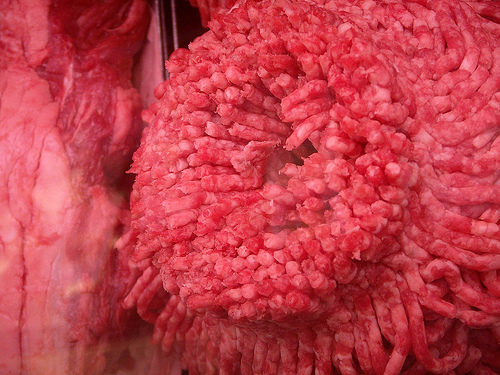
Photo by Cobalt123.
You didn’t think I’d miss my chance to weigh in on the latest round of pink slime discussions, did you? Rather than recapitulate the horror that is your favorite form of “lean finely textured beef,” I will instead point you to my favorite statement in defense of pink slime. It was given by American Meat Institute Director of Scientific Affairs Betsy Booren to NPR:
“This is not the same ammonia you’d use in cleaning supplies,” explains Betsy Booren of the AMI Foundation. “It’s a gas, it’s a different compound, and it’s a well-established processing intervention that has a long history of success.”
First off, the AMI Foundation? AMI’s own website identifies the group as “a national trade association that represents companies that process 95 percent of red meat and 70 percent of turkey in the U.S. and their suppliers throughout America.” Foundation my arse.
And granted, I’m no chemist — but my understanding is that the form of ammonia used in cleaning products is typically ammonium hydroxide. And the form used in pink slime is … ammonium hydroxide! The only difference is the household cleaner is a liquid and pink slime is treated with a gas.
But that’s not really the issue. When you have to defend your food production practice by saying, “Hey, at least we don’t use household cleaners on it!” you know you’ve got a big problem.
What pink slime represents is an open admission by the food industry that it is hard-pressed to produce meat that won’t make you sick. Because, I hate to break it to you folks, but ammonium hydroxide is just one in a long list of unlabeled chemical treatments used on almost all industrial meat and poultry.
Helena Bottemiller of Food Safety News dug up this United Stated Department of Agriculture document [PDF], which lists dozens of chemicals that processors can apply to meat without any labeling requirement. Things like calcium hypochlorite (also used to bleach cotton and clean swimming pools), hypobromous acid (also used as a germicide in hot tubs), DBDMH (or 1,3-dibromo-5,5-dimethylhydantoin, which is also used in water treatment), and chlorine dioxide (also used to bleach wood pulp), to name just a few.
All these chemicals can go on meat. Not that you’d know it, because both the industry and the USDA keep it on the down-low. In fact, they work together on this. The USDA requires processors to label certain approved antimicrobials, such as salt, spices, and even lemon as ingredients, but not their hard-to-pronounce brethren. Why not? Perhaps because it might shock and disgust consumers to know how thoroughly their meat must be chemically disinfected before it can be sold. USDA’s head of food safety Elizabeth Hagen told Bottemiller recently that, “Just being honest, I don’t think your average consumer probably knows a lot about how food is produced.” She’s right. We don’t know the half of it — and the more we find out, the angrier many of us get.
Andy Bellatti recently wrote a piece he called “Beyond Pink Slime,” in which he enumerates all the problems with industrial meat production that led it to this point. And in many ways pink slime is the perfect embodiment of a food industry gone off the rails.
In short, they took meat that was too dangerous to feed to humans, disinfected it so thoroughly that a block of the stuff will make your eyes water, and then celebrated the fact that they’d created a two-fer (it’s a food! it’s a disinfectant!). The industry embraced their creation so completely that around 70 percent of all supermarket ground beef now contains the stuff. But this goes way beyond hamburger. As Tom Philpott points out, pink slime is used in a huge variety of products including “hot dogs, lunch meats, chili, sausages, pepperoni, retail frozen entrees, roast beef, and canned foods.” By industry standards, it is nothing short of a food “intervention” success story.
The irony, of course, is that the 2010 debate over pink slime brought to light evidence that this treated meat product is not nearly as reliable a disinfecting agent as its maker asserted. It was likely those indications that led the fast food industry, in most ways farther ahead of the food safety curve than supermarkets or school food providers, to abandon the ingredient late last year. And now that the mainstream media has taken notice of pink slime, even the USDA has had to back off its wholehearted endorsement for it in school lunch.
But don’t let the appearance of a back-and-forth debate fool you. Pink slime is truly worse than other forms of disinfected treated meat since the trimmings used in pink slime are known to harbor pathogens at high levels before treatment. Should it disappear from store shelves, however, we can rest assured the meat that remains will continue to be treated with other industrial chemicals. Because that’s — pure and simple — the only way the industrial meat industry can prevent its products from making people sick.
I’d like to see more consumers and media outlets asking why exactly that is.



